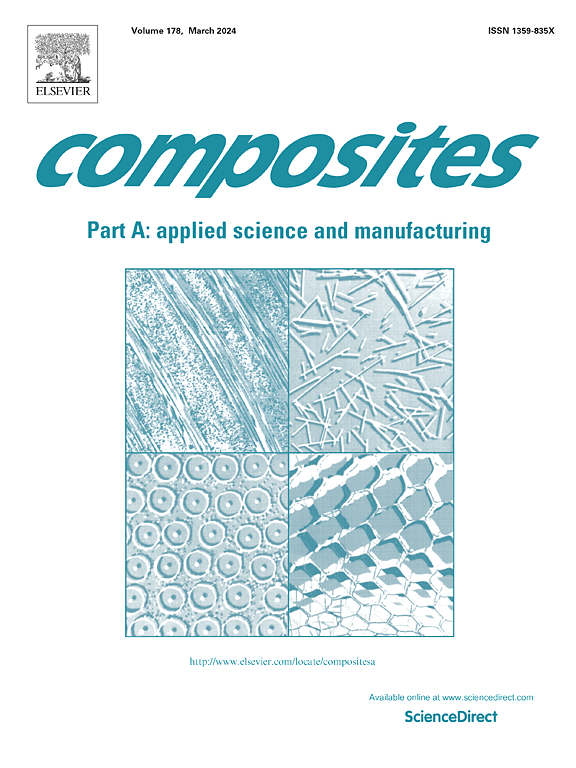Regulating the electro-dielectric architectures of carbon black-engineered polyester fibers and fabrics for strain sensing and microwave absorption
IF 8.1
2区 材料科学
Q1 ENGINEERING, MANUFACTURING
Composites Part A: Applied Science and Manufacturing
Pub Date : 2025-05-06
DOI:10.1016/j.compositesa.2025.109015
引用次数: 0
Abstract
With the advent of next-generation high-frequency wireless electronic sensors, signal interference between sensors become severe. Integrating the sensor and microwave absorber is highly needed, but challenges remain in a single-component material due to the contradiction between electrical conductivity and dielectric properties. Here, a one-step surface sizing of polyester fibers (PET) and coating of carbon black (CB) using styrene-acrylic emulsion (SAE) as sizing regent was proposed to produce multifunctional fibers (PET-SAE/C) continuously. This approach endows the fibers with balanced electrical conductivity and dielectric properties, making them a promising material for strain sensors and microwave absorbers. The obtained PET-SAE/C fibers exhibit remarkable sensitivity to the resistance changes over 1000 cycles of strain-sensing treatment. Simultaneously, the PET-SAE/C fibers had strong microwave absorption properties with a minimum reflection loss (RLmin) of −67.82 dB at a predicted thickness of 2.28 mm. The fibers were successfully weaved into 3D fabrics, which retained outstanding strain sensing and microwave absorption performance, the RLmin approached −62.87 dB at the thickness of 2.28 mm. This study provides insights into creating flexible, efficient, and multifunctional fiber and fabric materials for integrating strain sensors and microwave absorbers in versatile wireless electronics.

调节炭黑工程聚酯纤维和织物的电介质结构,用于应变传感和微波吸收
随着下一代高频无线电子传感器的出现,传感器之间的信号干扰变得越来越严重。集成传感器和微波吸收体是非常必要的,但由于电导率和介电性能之间的矛盾,单组分材料仍然存在挑战。本文提出了以苯乙烯-丙烯酸乳液(SAE)为施胶剂对聚酯纤维(PET)和炭黑(CB)涂层进行一步表面施胶的方法,以连续生产多功能纤维(PET-SAE/C)。这种方法使纤维具有平衡的导电性和介电性能,使其成为应变传感器和微波吸收器的有前途的材料。得到的PET-SAE/C纤维对1000次应变传感处理后的电阻变化表现出显著的敏感性。同时,PET-SAE/C纤维具有较强的微波吸收性能,在预测厚度为2.28 mm时,最小反射损耗(RLmin)为−67.82 dB。该纤维成功编织成三维织物,保持了优异的应变传感和微波吸收性能,在厚度为2.28 mm时,RLmin接近- 62.87 dB。该研究为在多功能无线电子产品中集成应变传感器和微波吸收器的柔性、高效和多功能纤维和织物材料提供了见解。
本文章由计算机程序翻译,如有差异,请以英文原文为准。
求助全文
约1分钟内获得全文
求助全文
来源期刊

Composites Part A: Applied Science and Manufacturing
工程技术-材料科学:复合
CiteScore
15.20
自引率
5.70%
发文量
492
审稿时长
30 days
期刊介绍:
Composites Part A: Applied Science and Manufacturing is a comprehensive journal that publishes original research papers, review articles, case studies, short communications, and letters covering various aspects of composite materials science and technology. This includes fibrous and particulate reinforcements in polymeric, metallic, and ceramic matrices, as well as 'natural' composites like wood and biological materials. The journal addresses topics such as properties, design, and manufacture of reinforcing fibers and particles, novel architectures and concepts, multifunctional composites, advancements in fabrication and processing, manufacturing science, process modeling, experimental mechanics, microstructural characterization, interfaces, prediction and measurement of mechanical, physical, and chemical behavior, and performance in service. Additionally, articles on economic and commercial aspects, design, and case studies are welcomed. All submissions undergo rigorous peer review to ensure they contribute significantly and innovatively, maintaining high standards for content and presentation. The editorial team aims to expedite the review process for prompt publication.
 求助内容:
求助内容: 应助结果提醒方式:
应助结果提醒方式:


